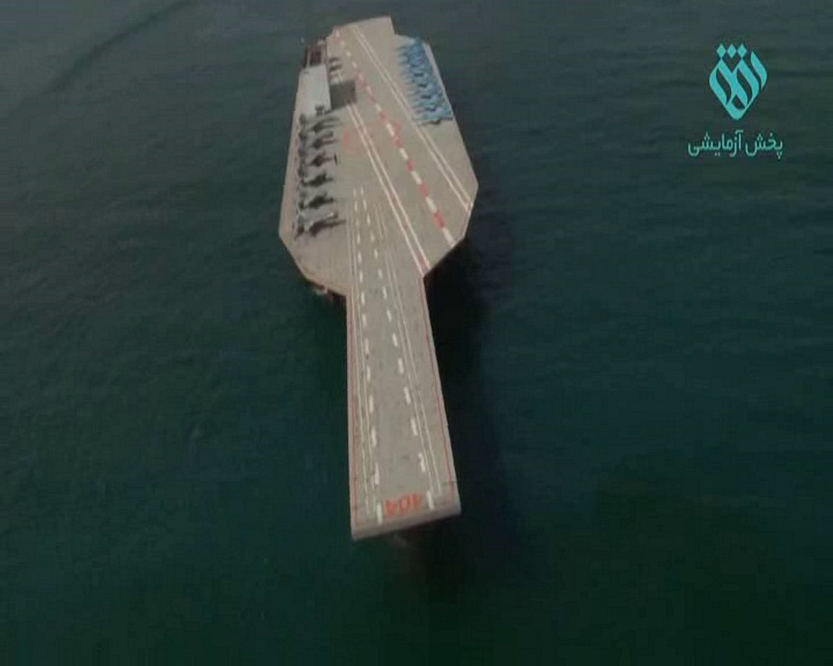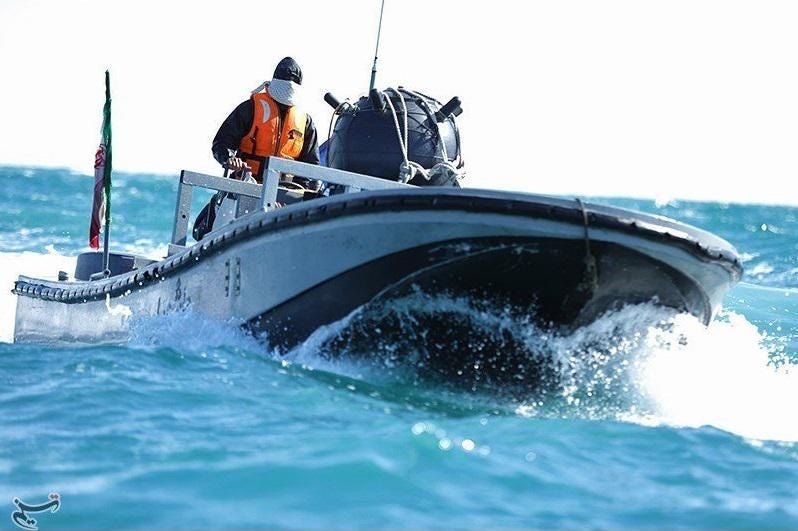Tehran plans to swarm U.S. ships with missiles and speedboats
Iran has carried out a massive attack on a mock version of an American Nimitz-class aircraft carrier. Tehran wanted everyone to know about it—state TV broadcasted the military exercise live.
It’s
a revealing look at Iranian naval assault tactics, involving several
waves of ships backed by helicopters and shore-launched missiles. The
timing isn’t a coincidence. The United States and Iran are deadlocked
over a deal to curb Tehran’s nuclear program.
The
Iranians built the giant, 1:1-scale mock-up of the carrier on top of a
barge almost one year ago. Photos released from Iranian news agencies on
Feb. 25 now show it as a smoldering wreck. The missiles Iran fired at
it are very real.
But don’t
panic. The exercise—known as Great Prophet 9—didn’t factor in American
escort warships and warplanes responsible for defending real carriers. It was mostly just for show.
The
exercise occurred near Larak Island near the Strait of Hormuz. On the
island, Mohammad Ali Jafari—the chief of Iran’s Revolutionary Guards
Corps—and the head of the conservative parliament watched from stands.
First,
IRGC navy speedboats performed a mining operation to isolate the
“carrier” and limit its maneuverability. Dozens of small speedboats—each
armed with an M-08 contact mine—swarmed around the mock up. Iranian
state television claimed “a vast area was mined in under 10 minutes.”
During
the second phase, the speedboats attacked the giant ship with
107-millimeter rockets. These are small rockets, and likely couldn’t
sink a warship the size of an aircraft carrier.
But Iran could intend this tactic as a means to disable critical self-defense systems, such as radars, Phalanx CIWS self-defense cannons and missile launchers.
Next,
speedboats armed with small cruise missiles—likely Chinese-made C-704
anti-ship cruise missiles—attacked the ship. These fast speedboats fired
a barrage of 12 cruise missiles toward the mock Nimitz.
The
third phase included a barrage of heavy, shore-launched anti-ship
missiles. Iran launched two cruise missiles and two ballistic missiles
toward the barge in a coordinated attack.
 |
| Above—the mock-up carrier |
 |
| The mock-up burns. Iranian TV and state media photos |
 |
 |
| Iranian speedboats. |
The shore-launched cruise missiles were Iranian-made Noor
missiles, copies of Chinese C-802 missiles produced under license. The
ballistic missiles were Fateh-100 variants fitted with target-seeking
infrared nose cameras. At least one of those missed its target.
The
fourth phase was an unconventional attack … even by IRGC standards. A
commercial Bell 206 helicopter fired a C-704K anti-ship cruise missile
from between its skids.
The last phase involved ramming a remotely-controlled suicide boat packed with more than 1,000 kilograms of high explosives into the mock up.
Jafari
directly threatened the U.S. Navy in an interview after the attack. He
said that it only takes five minutes for IRGC missiles to sink American
aircraft carriers. Five hundred speed boats made a parade in the Strait
of Hormuz following the exercise.
But
in a real encounter, it’s unlikely that such a scenario would succeed.
To reach and flank a U.S. aircraft carrier—and mine the surrounding
area—Iran’s speed boats would also have to fight past the flattop’s advanced escort warships.
Carriers don’t go anywhere without escorts. And that wasn’t part of the exercise.
Iran
also didn’t provide any substantial air defenses for its own ships. A
defending carrier is unlikely to sit idle when under attack. In a real
battle, U.S. Marines with Mark V speedboats armed with Javelin anti-tank
missiles could also provide a defense shield for the American fleet.
But the use of commercial helicopters is concerning. Iran’s military has worked on flying swarms of small aircraft for some time.
Another
possibility is that Iran doesn’t intend to use helicopters in an actual
attack on a carrier, but is broadcasting its ability to use helicopters
against other targets—such as unprepared U.S. ships abroad, akin to the
suicide-boat attack on the destroyer USS Cole more than 14 years ago.
The
question is—why practice attacking an American carrier right now?
Simple. It was an impressive show of force aimed to affect ongoing
nuclear talks with Washington.
From
the negotiations in Geneva to a disastrous war in Syria, the Iranian
regime’s plans to save its sinking economy and preserve its strategic
ally in the Middle East are going down in flames.
U.S. Secretary of State John Kerry recently said the U.S. is ready to abandon negotiations aimed at limiting Iran’s nuclear program in exchange for lifting sanctions. Syrian troops are carrying out a desperate offensive to encircle Aleppo. At least 150 Syrian troops and an IRGC general have died in the offensive.
To have any hope of holding the U.S. to the negotiations, Tehran has to remind the world what could happen if talks break down.
----------------------------------------------
Al Jazeera to leak spy files
Al Jazeera, also known as Aljazeera and JSC, is a Doha-based broadcaster owned by the Al Jazeera Media Network, which is funded by the House of Thani, the ruling family of Qatar. To be leaked: Israel's Mossad, Britain's MI6, Russia's FSB, Australia's ASIO and South Africa's SSA and Sudan's NISS
Pakistan Media claiming Balochistan Liberation Army has been eliminated

Post a Comment Blogger Facebook Disqus